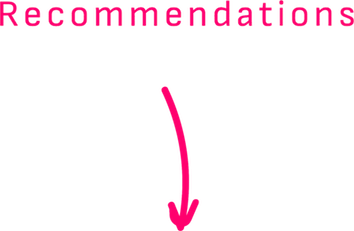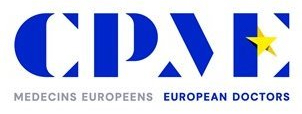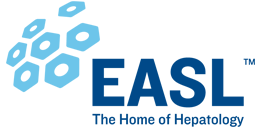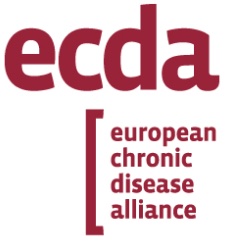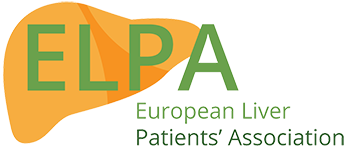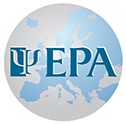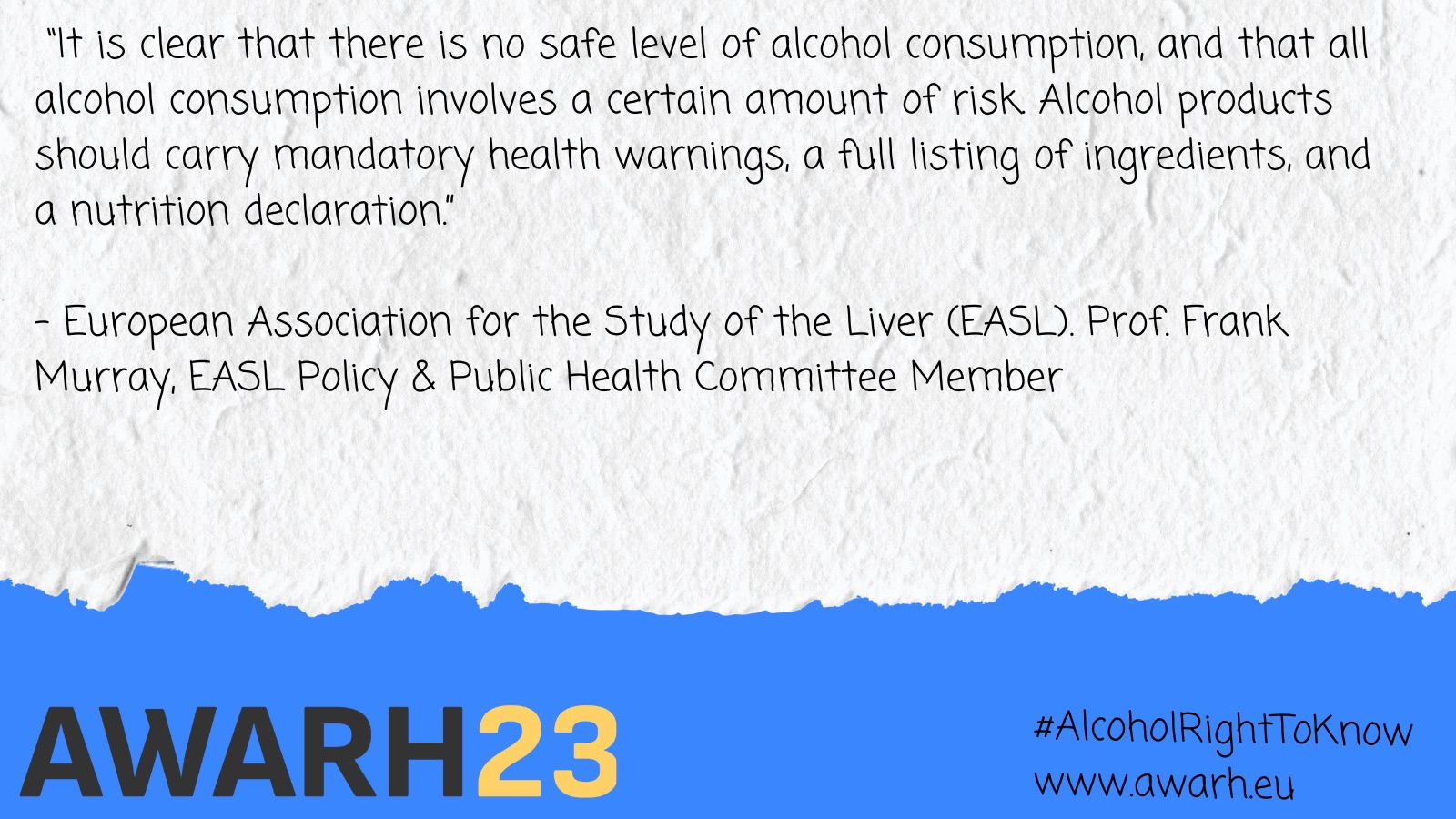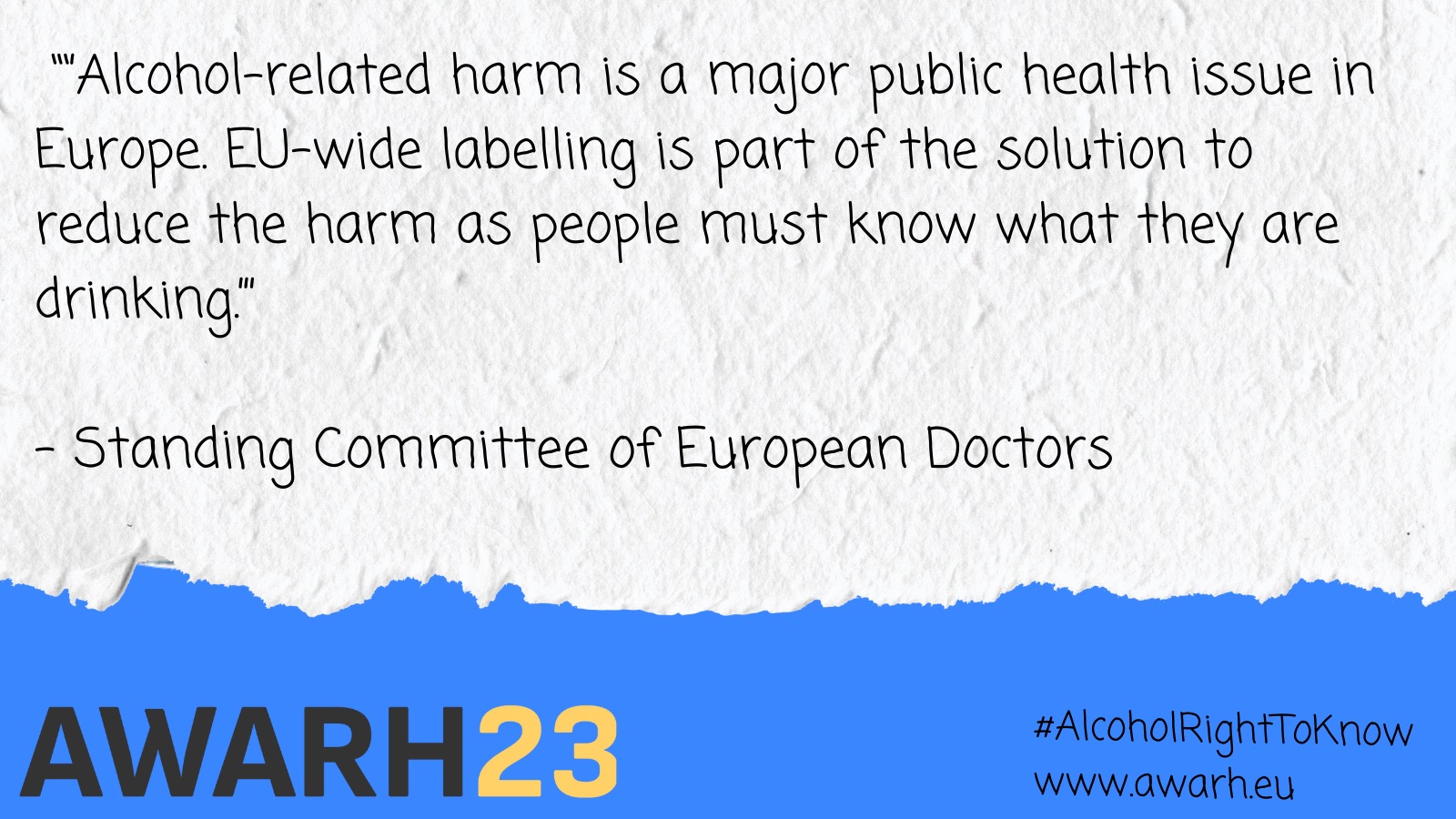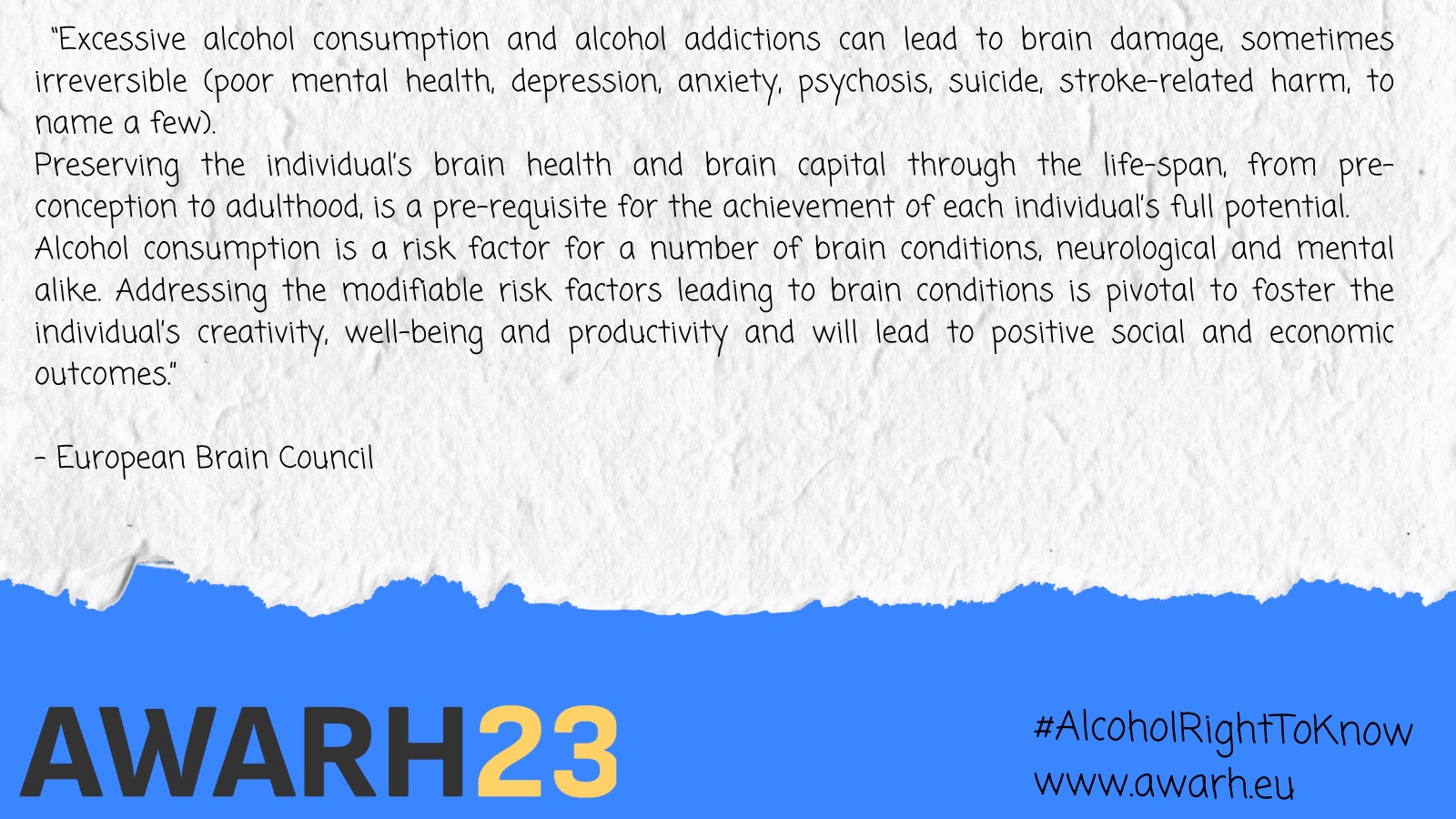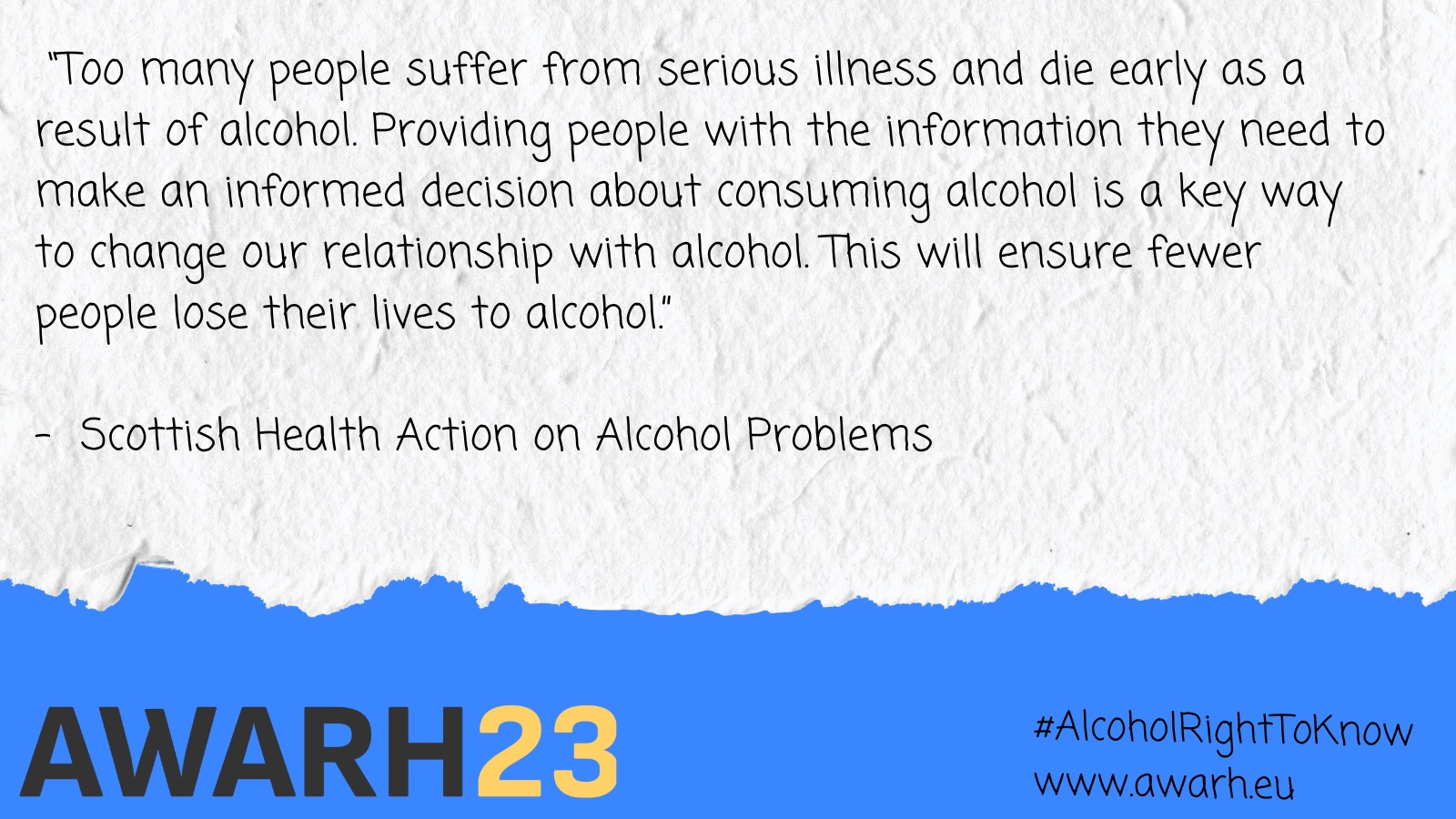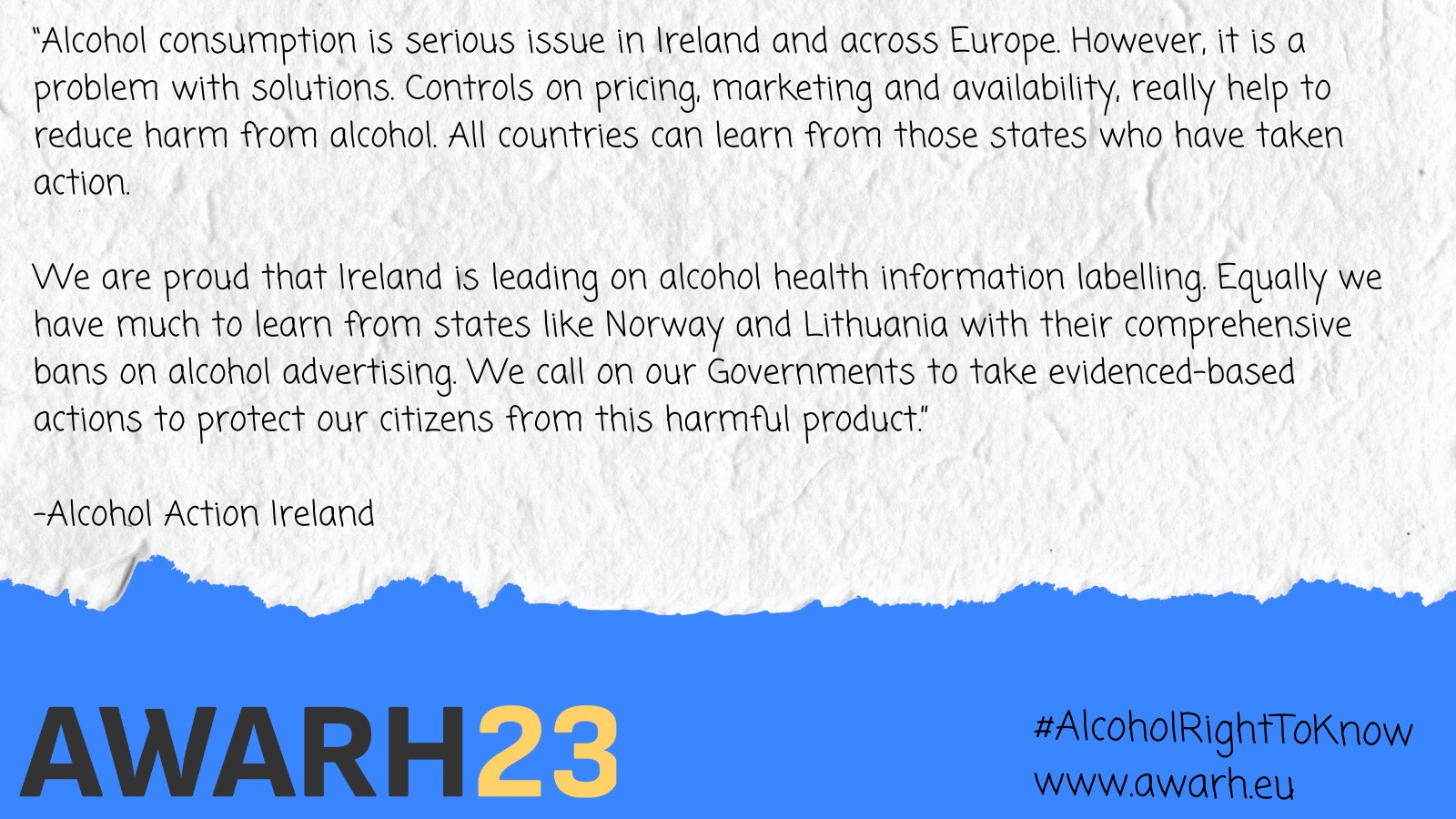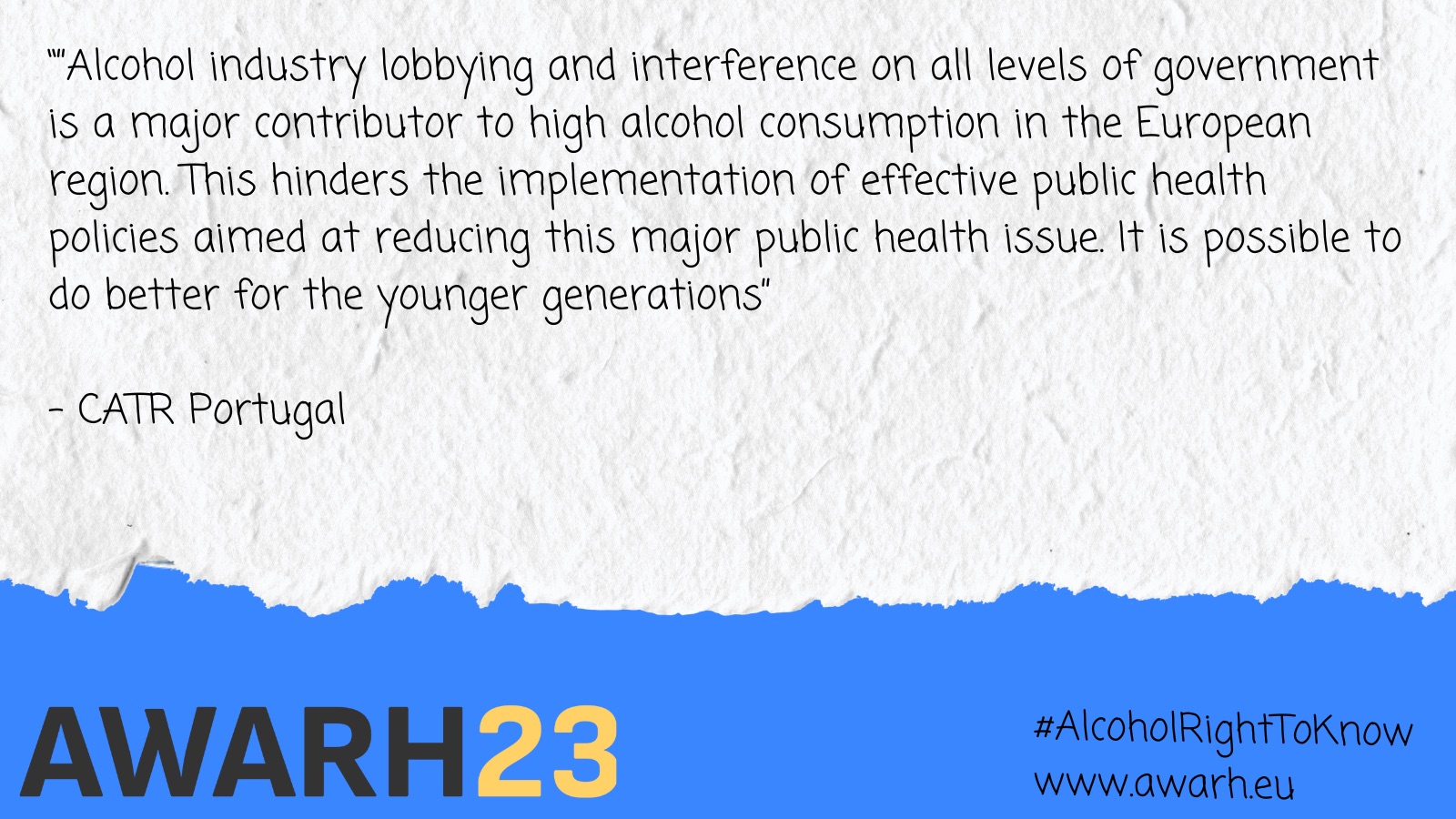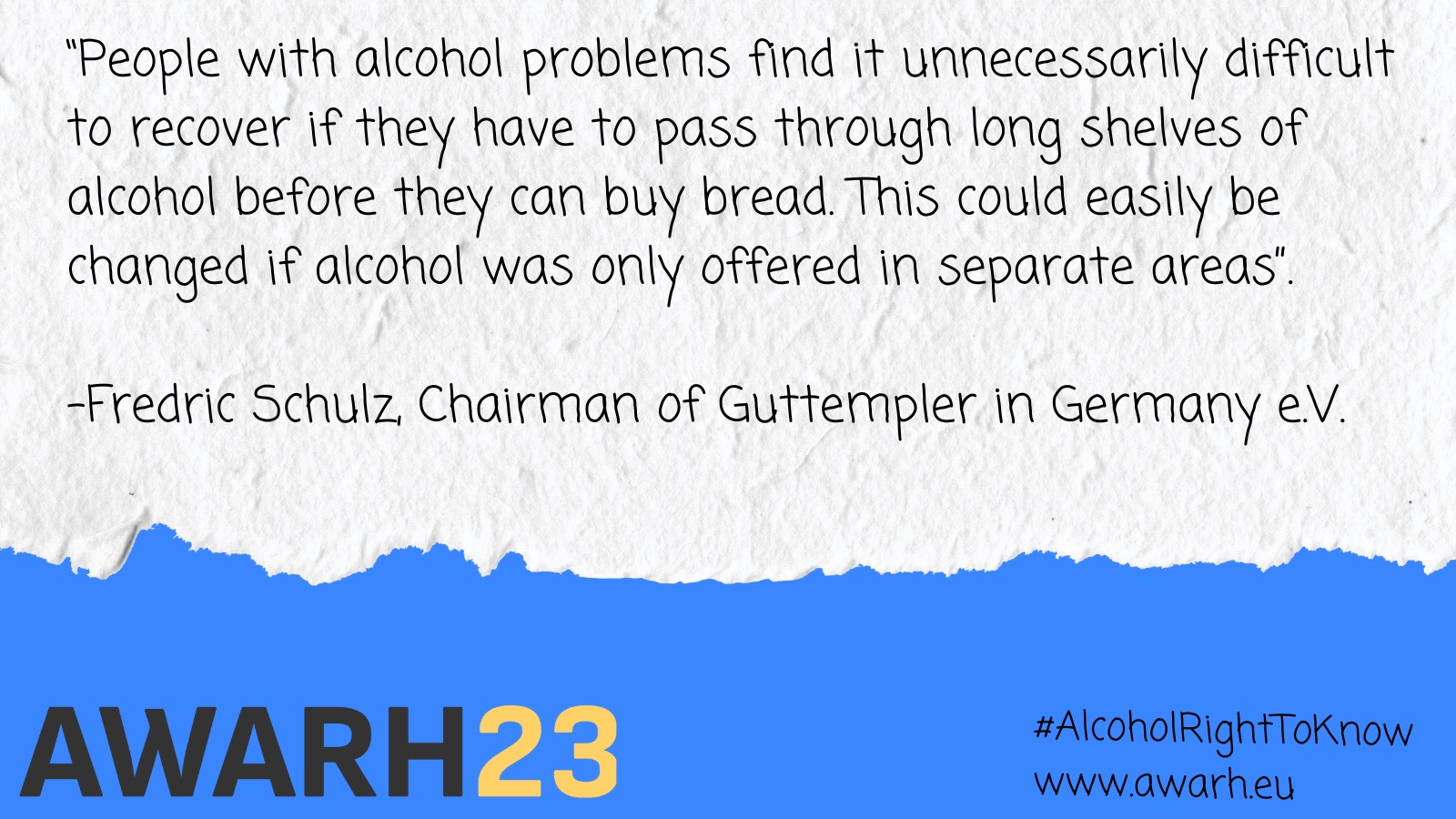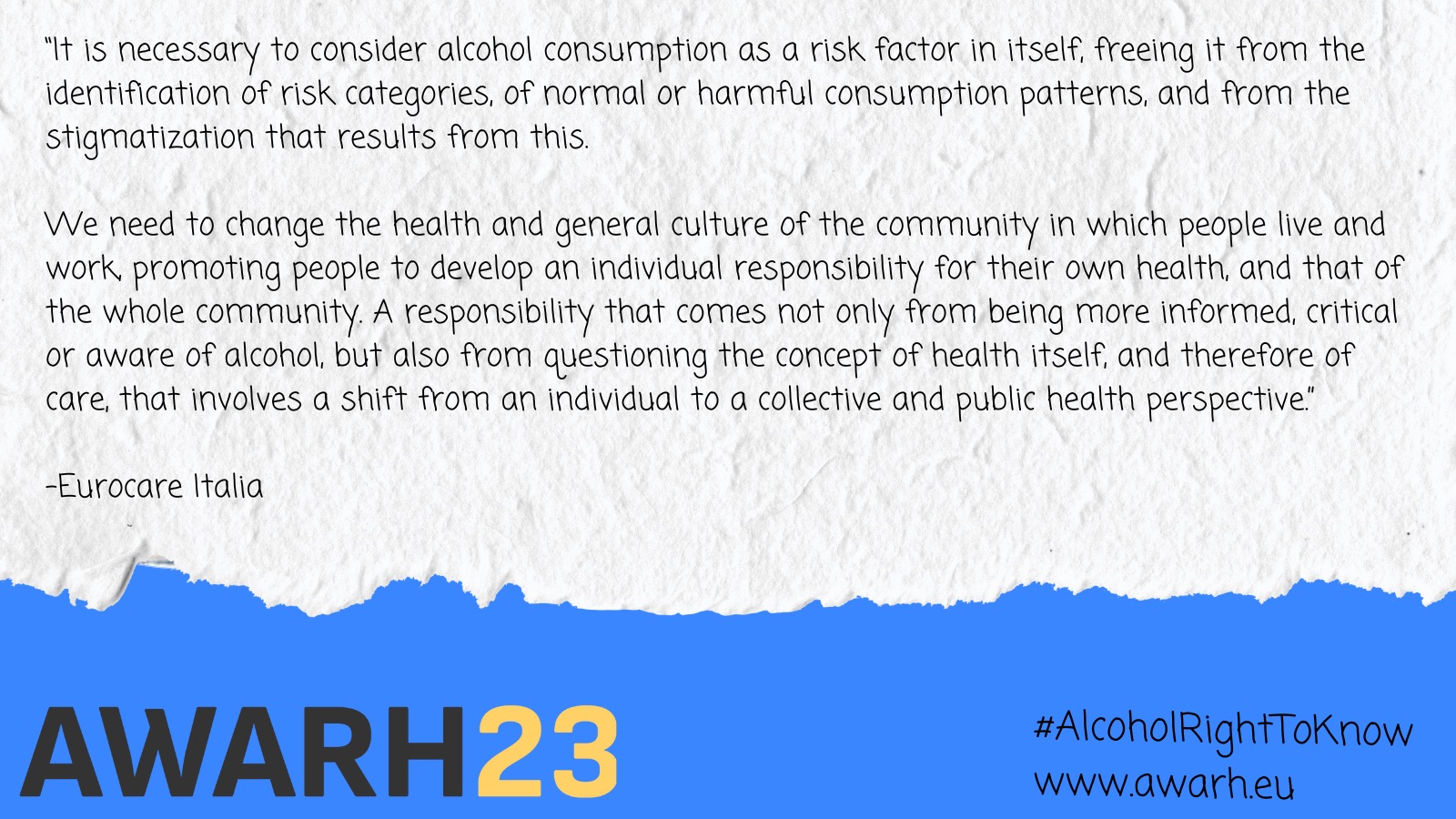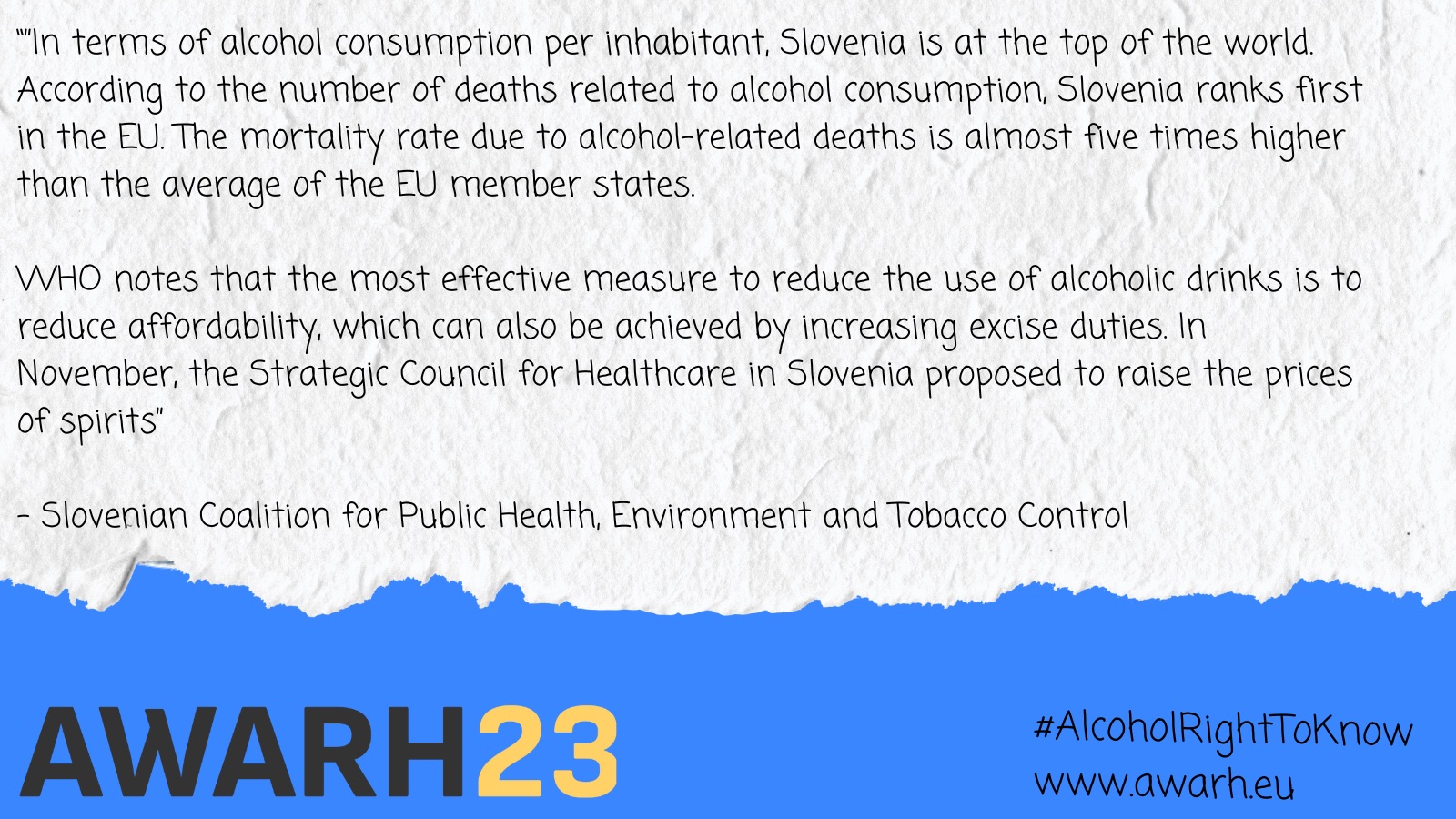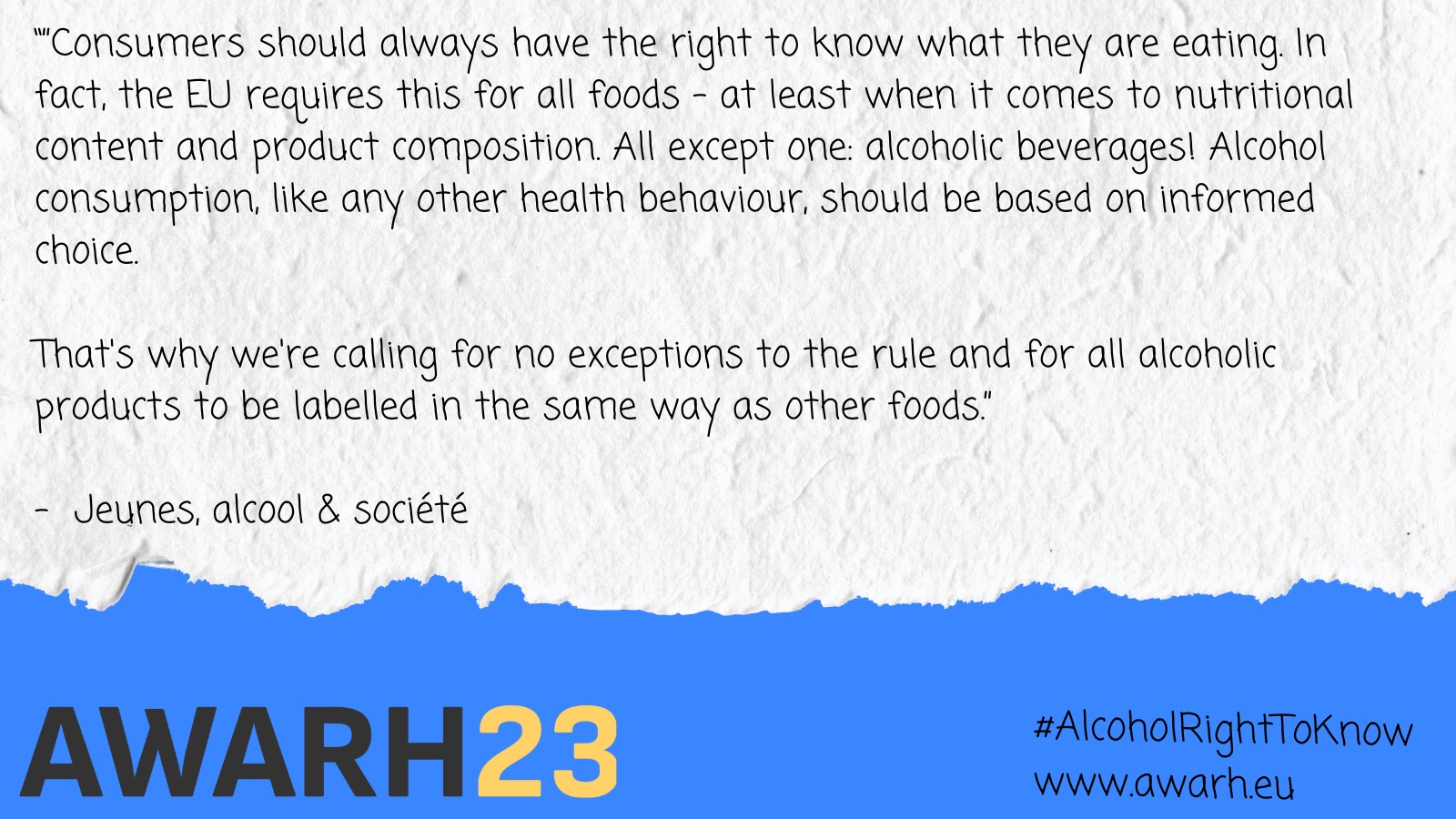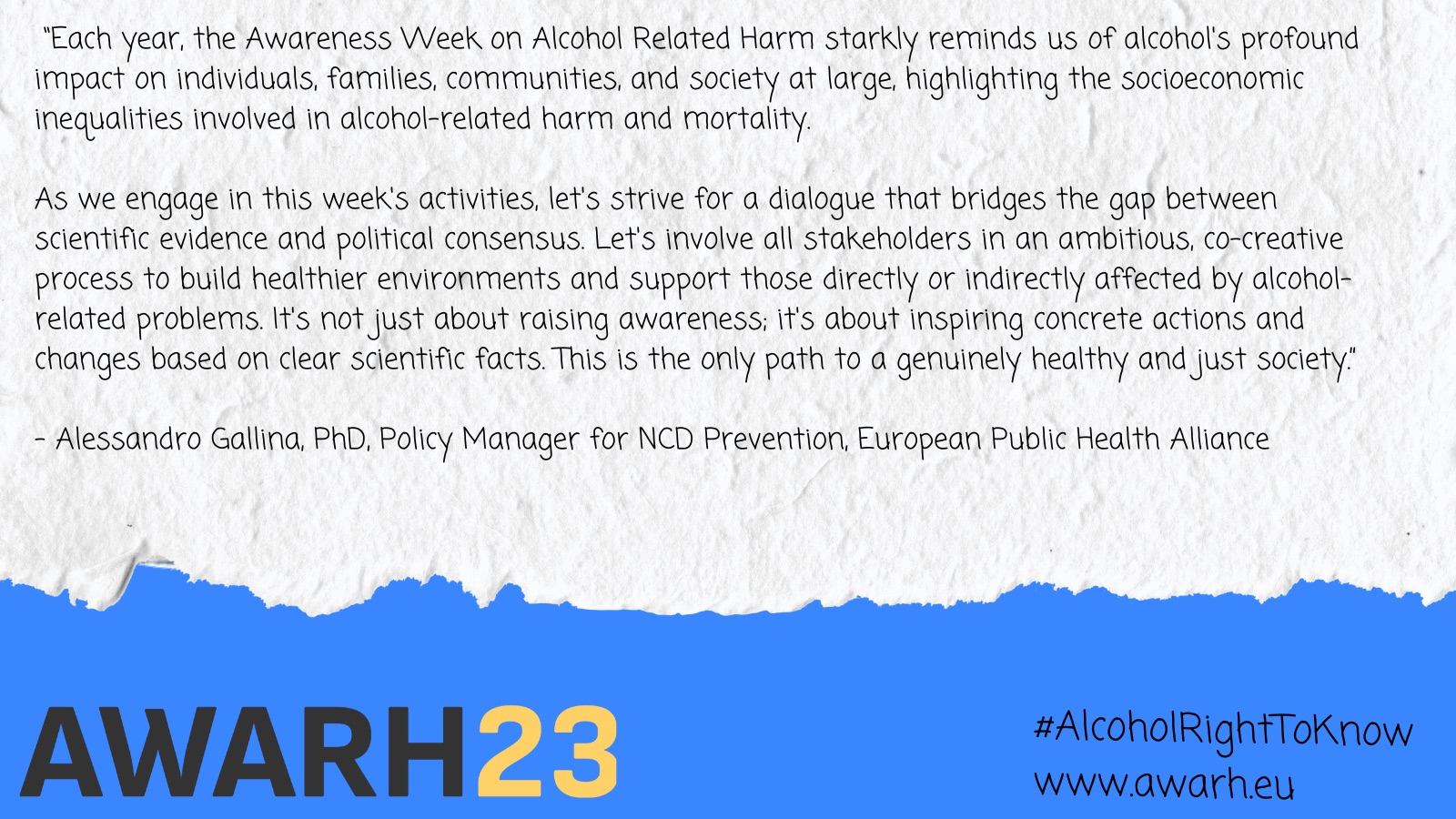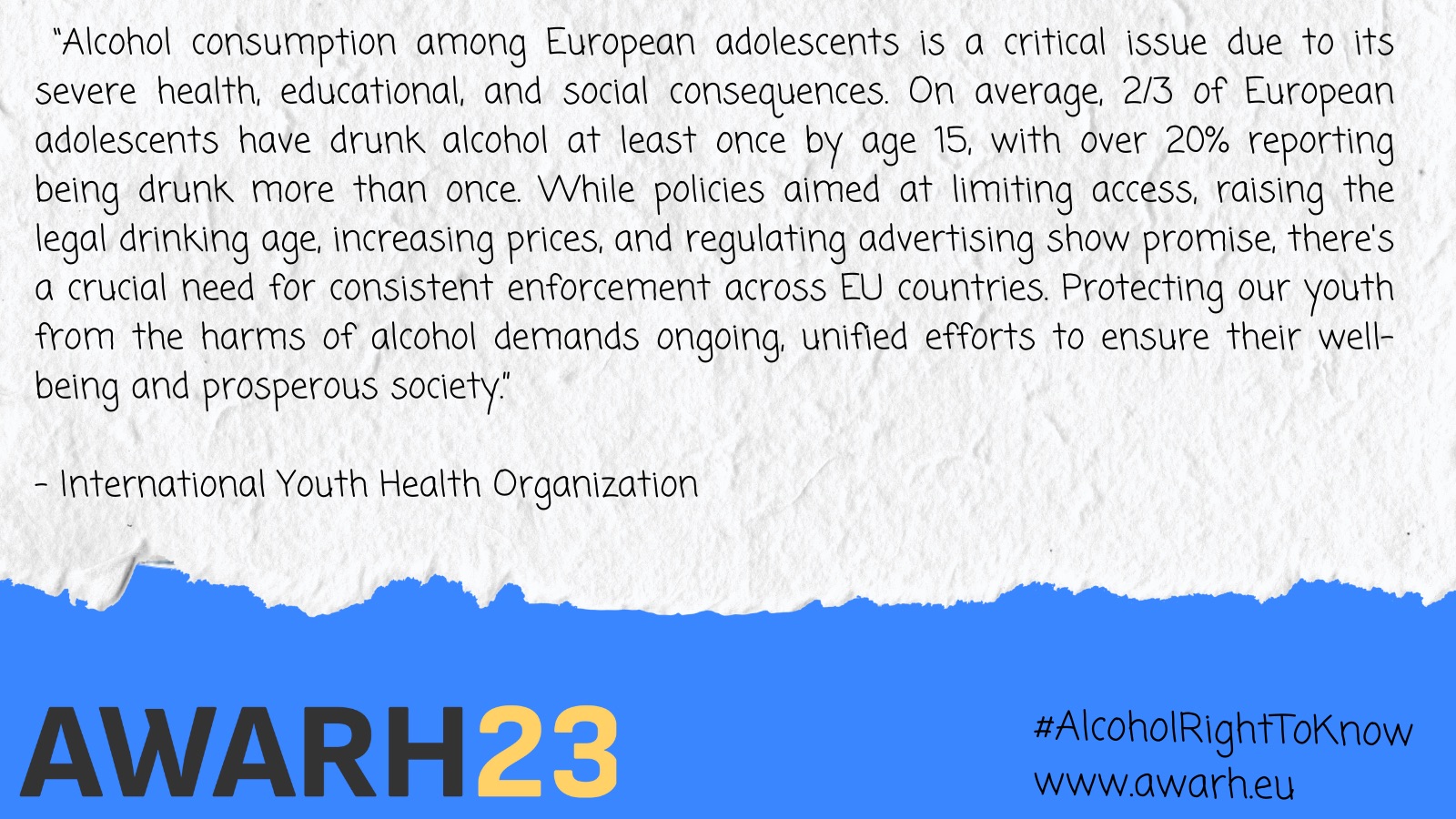
Awareness Week
on Alcohol Related Harm
![]() 27 NOVEMBER – 3 DECEMBER 2023
27 NOVEMBER – 3 DECEMBER 2023

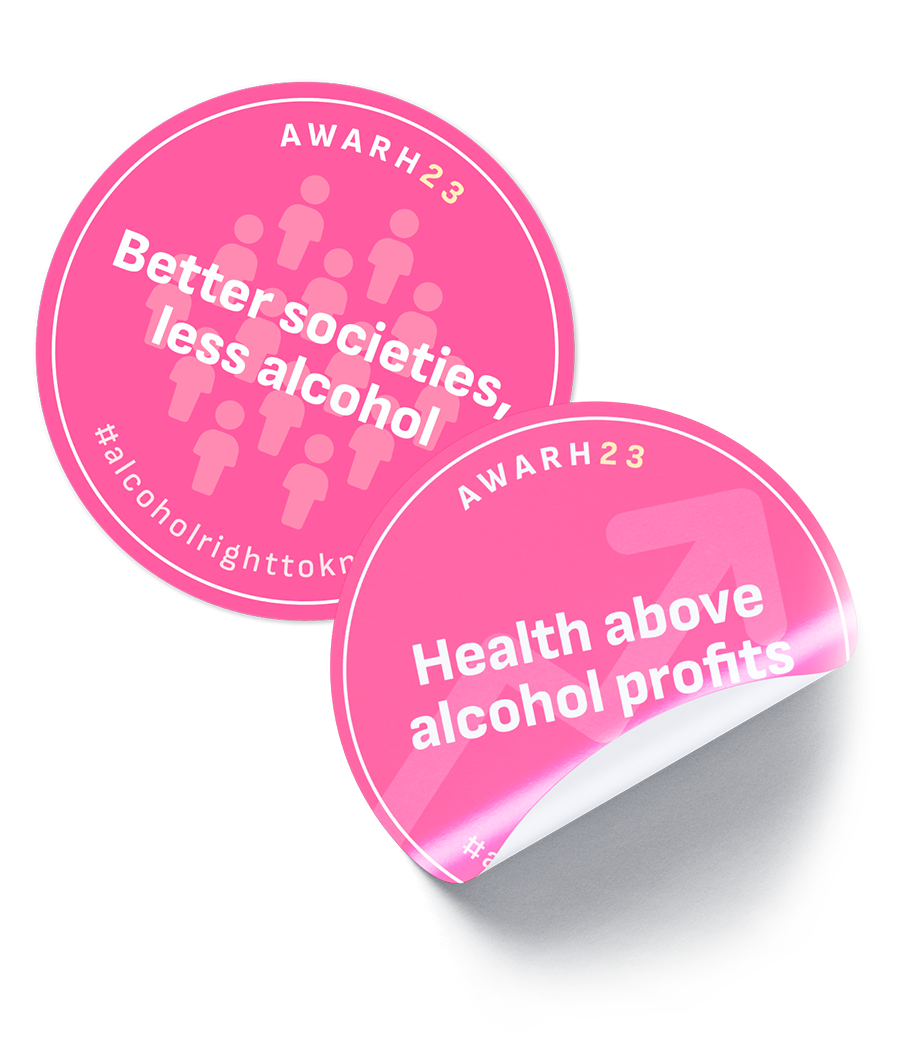


What’s AWARH23
AWARH23: People speak to policy makers
“A glass of alcohol won’t kill you but a law can save thousands of lives”
In Europe, every minute, policy makers have an opportunity to save lives by addressing the high levels of alcohol consumption that uniquely affect our region. Millions of people suffer from health issues, violence, injuries, job losses, and various other harms.
The Awareness Week on Alcohol Related Harm 2023 (AWARH23) is set to capture the attention of policy makers, bringing to light the critical issue of alcohol-related harm in Europe. Starting on Monday, November 27th, this campaign aims to create a positive change.
We encourage policy makers to listen to the video stories addressed to them, to follow AWARH23 on social media and to share our cause.
Let’s ensure that the facts and policy solutions for alcohol harm are heard loudly and clearly, with the hope of making a positive impact on the lives of many. There is no excuse for not taking action to protect citizens from alcohol-related harm.

The facts all policy makers should know
Select the category:
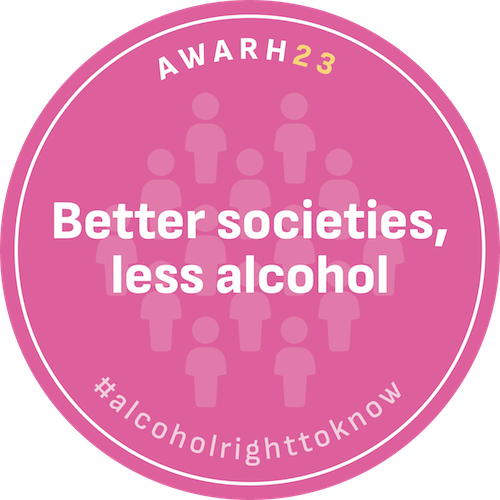
Better societies,
less alcohol
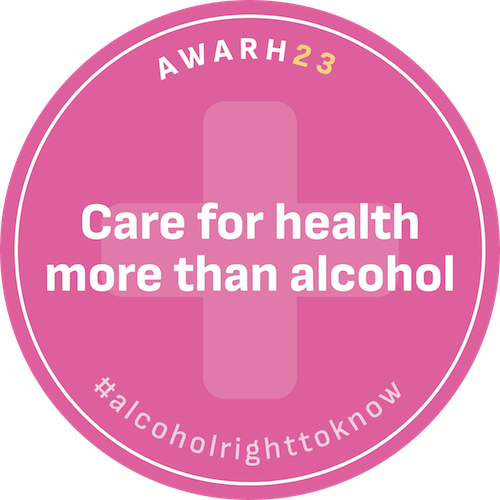
Care for health more
then alcohol
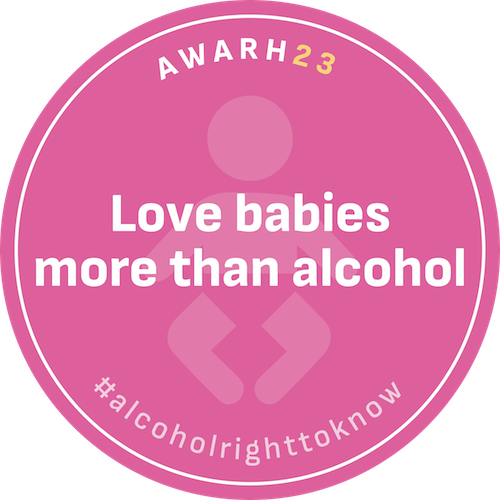
Love babies
more than alcohol
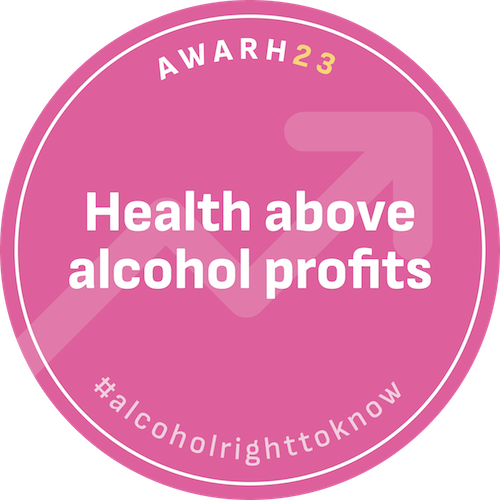
Health above
alcohol profits
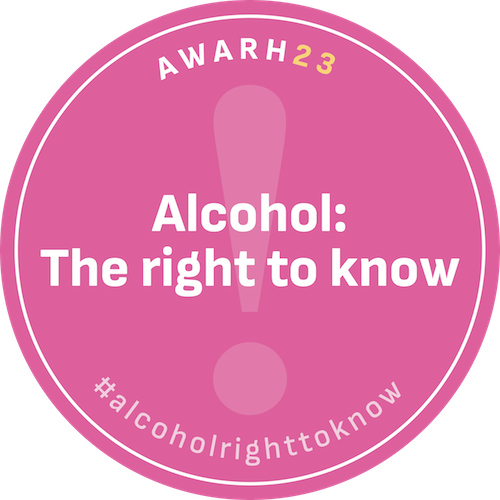
Alcohol:
The right to know





1. Better societies, less alcohol
Less alcohol, safer Europe
Europe has the highest global alcohol consumption, obesity, and ultra-processed food consumption, all contributing to liver-related morbidity and mortality. Liver-related mortality is closely linked to population-level alcohol intake, emphasizing the importance of reducing alcohol-associated liver disease. Models may underestimate its incidence due to under-reporting. Europe has the highest per capita alcohol consumption, a significant prevalence of heavy episodic drinking, and low abstention rates worldwide. The most effective means to lower mortality from alcohol-related liver disease, a dose-related condition, is through interventions that curb population-level alcohol consumption.
Show me the science
European Association for the Study of the Liver, citing
Tom H Karlsen et al. The EASL–Lancet Liver Commission: protecting the next generation of Europeans against liver disease complications and premature mortality. The Lancet 2022; Vol 399 (January 1): 65-116
https://www.thelancet.com/article/S0140-6736(21)01701-3/fulltext
Daniel Q Huang et al. Global epidemiology of alcohol-associated cirrhosis and HCC trends, projections, and risk factors. Gastroenterology and Hepatology Review; 1-4
https://www.nature.com/articles/s41575-022-00688-6
Moodie R, Stuckler D, Monteiro C, et al. Profits and pandemics: prevention of harmful effects of tobacco, alcohol, and ultraprocessed food and drink industries. Lancet 2013; 381: 670–79.
https://www.thelancet.com/journals/lancet/article/PIIS0140-6736(12)62089-3/fulltext
WHO. Global status report on alcohol and health 2018. September 2018.
https://www.who.int/publications/i/ item/9789241565639
Karlsen TH, Sheron N, Zelber-Sagi S, et al. The EASL–Lancet Liver Commission: protecting the next generation of Europeans against liver disease complications and premature mortality. The Lancet 2021.
https://www.thelancet.com/pdfs/journals/lancet/PIIS0140-6736(21)01701-3.pdf
Less alcohol, less violence
Despite the attention paid to drugs like GHB or burundanga, alcohol is the most commonly consumed drug in situations of sexual violence in nightlife and party environments. Alcohol acts as an enhancer and facilitator of structural gender inequality which mainly affects women and gender-diverse people.
See the resources
Plaza, L., Ferrer, R. & Vale Pires, C. (2022). Sexism Free Night – Research Report. Sexism Free Night European Project.
http://www.sexismfreenight.eu
Less alcohol, better habits
Recent studies conducted in England suggest changes in alcohol consumption during the pandemic are likely to lead to thousands of additional cases, premature deaths and hospital admissions for conditions such as liver cirrhosis, colon and rectum cancer, liver cancer and oesophageal cancer, with the largest increases in harm expected in the most disadvantaged communities.
See the resources
Rose, TC, Pennington, A, Kypridemos, C, Chen, T, Subhani, M, Hanefeld, J, et al. Analysis of the burden and economic impact of digestive diseases and investigation of research gaps and priorities in the field of digestive health in the European Region—White Book 2: executive summary. United European Gastroenterol J. 2022; 10( 7): 659– 64. https://doi.org/10.1002/ueg2.12298
Less alcohol, less stigma
Stigma is a public health, medical, and ethical issue, being a consequence of health inequities as well as a key driver in perpetuating them. People with, or at risk of developing, liver disease frequently belong to highly stigmatised groups. This is particularly the case when it results from alcohol use. Stigma has a major impact on liver diseases in Europe, leading to discrimination, reduction in healthcare seeking behaviour, and reduced allocation of resources, which all result in poor clinical outcomes. This, ultimately, can worsen social inequalities by negatively affecting employment, social relationships, and educational opportunities.
See the resources
The EASL-Lancet Commission. 2021. Protecting the next generation of Europeans against liver disease complications and premature mortality.
https://www.thelancet.com/commissions/liver-disease-europe
Less alcohol, longer lives
Reducing population alcohol consumption in Europe, with its high alcohol use, heavy episodic drinking, and low abstention rates, can significantly cut liver disease mortality. Cultural and historical shifts in alcohol consumption patterns, like France and Italy’s four-fold reduction with decreased cheap wine consumption, or the UK’s increased liver mortality due to stronger home alcohol consumption, highlight the importance of policies aimed at reducing population-level alcohol intake for swift reductions in liver mortality.
Show me the science
European Association for the Study of the Liver, citation
Tom H Karlsen et al. The EASL–Lancet Liver Commission: protecting the next generation of Europeans against liver disease complications and premature mortality. The Lancet 2022; Vol 399 (January 1): 65-116
https://www.thelancet.com/article/S0140-6736(21)01701-3/fulltext
Burton R, Henn C, Lavoie D, et al. A rapid evidence review of the effectiveness and cost-effectiveness of alcohol control policies: an English perspective. Lancet 2017; 389: 1558–80.
https://www.thelancet.com/journals/lancet/article/PIIS0140-6736(16)32420-5/fulltext
WHO. European action plan to reduce the harmful use of alcohol 2012–2020. 2012.
https://www.euro.who.int/__data/assets/pdf_file/0008/178163/E96726.pdf
Organisation for Economic Co-operation and Development. Preventing harmful alcohol use. May 19, 2021.
https://doi.org/10.1787/6e4b4ffb-en
Less alcohol, less diseases
Drinking alcohol is associated with a risk of developing health problems such as mental and behavioural disorders, including alcohol dependence, and major noncommunicable diseases such as liver cirrhosis, some cancers, and cardiovascular diseases.
See the resources
World Health Organisation, Alcohol fact sheet
https://www.who.int/news-room/fact-sheets/detail/alcohol
Less alcohol, less social inequalities
The risk factors for digestive disorders, including alcohol consumption, are socially patterned within most countries, meaning that exposure to these risks and the harm caused by them is to a large extent determined by an individual’s socioeconomic position. Systematic differences in lifestyles between social groups are shaped by structural factors, with those in lower socioeconomic positions having less access to resources and opportunities to achieve healthy lifestyles. Nonetheless behavioural risk factors are still sometimes portrayed as freely chosen–a narrative popular among tobacco, food and alcohol industries which profit from shifting corporate responsibility onto individuals. The introduction of evidence-based alcohol policies in Scotland was a likely contributor to a fall in alcohol related mortality, particularly among the lowest income groups, so health inequality narrowed.
See the resources
Rose, TC, Pennington, A, Kypridemos, C, Chen, T, Subhani, M, Hanefeld, J, et al. Analysis of the burden and economic impact of digestive diseases and investigation of research gaps and priorities in the field of digestive health in the European Region—White Book 2: executive summary. United European Gastroenterol J. 2022; 10( 7): 659– 64.
https://doi.org/10.1002/ueg2.12298
Monitoring and Evaluating Scotland’s Alcohol Strategy, Monitoring Report 2022, p17
https://www.publichealthscotland.scot/media/13693/mesas-2022_english_jun2022.pdf
2. Care for health more than alcohol
Care for hearts more than alcohol
No randomised control trial has ever shown alcohol conferring any benefit to the heart. The belief that it does has been firmly refuted by the World Heart Federation. Alcohol can damage heart muscle and it increases blood pressure contributing to heart disease and stroke.
See the resources
The impact of alcohol on cardiovascular health: Myths and measures, World Heart Federation, January 2022 https://world-heart-federation.org/wp-content/uploads/WHF-Policy-Brief-Alcohol.pdf
Care for breasts more than alcohol
Breast cancer is the most frequently diagnosed cancer type in the WHO European Region, with more than 1,500 women diagnosed every day. Alcohol consumption is one of the major modifiable risk factors for the disease, causing seven of every 100 new breast cancer cases in the region. Low-level drinkers run a slightly higher risk of breast cancer, while heavy drinkers have a 60% higher risk.
See the resources
Alcohol is one of the biggest risk factors for breast cancer, World Health Organization, October 2021
https://www.who.int/europe/news/item/20-10-2021-alcohol-is-one-of-the-biggest-risk-factors-for-breast-cancer
Bagnardi V, Rota M, Botteri E, Tramacere I, Islami F, Fedirko V, Scotti L, Jenab M, Turati F, Pasquali E, Pelucchi C, Galeone C, Bellocco R, Negri E, Corrao G, Boffetta P, La Vecchia C. Alcohol consumption and site-specific cancer risk: a comprehensive dose-response meta-analysis. Br J Cancer. 2015 Feb 3;112(3):580-93. doi: 10.1038/bjc.2014.579. Epub 2014 Nov 25. PMID: 25422909; PMCID: PMC4453639.
https://doi.org/10.1038/bjc.2014.579
Buykx, P., Li, J., Gavens, L. et al. Public awareness of the link between alcohol and cancer in England in 2015: a population-based survey. BMC Public Health 16, 1194 (2016). https://doi.org/10.1186/s12889-016-3855-6
Tamimi Rm, Spiegelman D, Smith-Warner SA, Wang M, Pazaris M et al. Population attributable risk of modifiable and nonmodifiable breast cancer risk factors in postmenopausal breast cancer. Am J Epidemiol. 2016; 184(12):884-93. Available from:
https://doi.org/10.1093/aje/kww145
Care for digestive systems more than alcohol
Alcohol consumption, in particular, is a risk factor in 200 disease and injury conditions, with nearly 30% of deaths from gastrointestinal diseases directly attributed to alcohol. The European region has the world’s highest proportion of total ill health and premature death linked directly to alcohol consumption.
See the resources
– UEG. Alcohol and Digestive Cancers Across Europe: Time for Change (2017):
https://ueg.eu/files/352/371bce7dc83817b7893bcdeed13799b5.pdf
– World Health Organisation. 2014. Global status report on alcohol and health 2014. Available at:
https://apps.who.int/iris/bitstream/handle/10665/112736/9789240692763_eng.pdf;jsessionid=E166515EF9677642EEEA37BCE1F079B7?sequence=1
Care for colons more than alcohol
The International Agency for Research on Cancer (IARC) added colorectal cancer to the list of cancers causally related to alcohol in 2007. Meta-analysis examining the association between alcohol consumption and colorectal cancer risk shows there is an increased risk of 21% in those who consume between one and four alcoholic drinks a day and as much as a 52% increased risk in those who consume more than four drinks a day
See the resources
UEG. Alcohol and Digestive Cancers Across Europe: Time for Change (2017)
https://ueg.eu/files/352/371bce7dc83817b7893bcdeed13799b5.pdf
Bagnardi V, Rota M, Botteri E, Tramacere I, Islami F, Fedirko V, Scotti L, Jenab M, Turati F, Pasquali E, Pelucchi C, Galeone C, Bellocco R, Negri E, Corrao G, Boffetta P, La Vecchia C. Alcohol consumption and site-specific cancer risk: a comprehensive dose-response meta-analysis. Br J Cancer. 2015 Feb 3;112(3):580-93. doi: 10.1038/bjc.2014.579. Epub 2014 Nov 25. PMID: 25422909; PMCID: PMC4453639
https://www.ncbi.nlm.nih.gov/pmc/articles/PMC4453639/
Care for livers more than alcohol
Did you know that alcohol-related liver disease is preventable, and there’s an exponential relationship between alcohol intake and cirrhosis? Effective policies, such as pricing strategies and restrictions on availability and marketing, can significantly reduce liver disease. The volume and pattern of alcohol consumption directly affect the harm it causes, with a strong correlation between population-level alcohol consumption and liver-related mortality in many countries.
See the resources
Burton R, Henn C, Lavoie D, et al. A rapid evidence review of the effectiveness and cost-effectiveness of alcohol control policies: an English perspective. Lancet 2017; 389: 1558–80.
https://www.thelancet.com/journals/lancet/article/PIIS0140-6736(16)32420-5/fulltext
Organisation for Economic Co-operation and Development. Preventing harmful alcohol use. May 19, 2021.
https://doi.org/10.1787/6e4b4ffb-en
Karlsen TH, Sheron N, Zelber-Sagi S, et al. The EASL–Lancet Liver Commission: protecting the next generation of Europeans against liver disease complications and premature mortality. The Lancet 2021; published online Dec 2.
https://www.thelancet.com/article/S0140-6736(21)01701-3/fulltext
Rehm J, Taylor B, Mohapatra S, et al. Alcohol as a risk factor for liver cirrhosis: a systematic review and meta-analysis. Drug Alcohol Rev 2010; 29: 437–45.
https://onlinelibrary.wiley.com/doi/abs/10.1111/j.1465-3362.2009.00153.x
Ndugga N, Lightbourne TG, Javaherian K, et al. Disparities between research attention and burden in liver diseases: implications on uneven advances in pharmacological therapies in Europe and the USA. BMJ Open 2017.
https://bmjopen.bmj.com/content/7/3/e013620
Karlsen TH, Sheron N, Zelber-Sagi S, et al. The EASL–Lancet Liver Commission: protecting the next generation of Europeans against liver disease complications and premature mortality. The Lancet 2021.
https://www.thelancet.com/article/S0140-6736(21)01701-3/fulltext
Care for future more than alcohol
Alcohol is a group 1 carcinogen, the same category as tobacco and asbestos as a cancer-causing agent. It causes at least seven types of cancer with the risk increasing in line with alcohol exposure, with heavy drinkers running up to five times the risk of non-drinkers and even low levels of alcohol consumption bring significant risk.
See the resources
WHO, International Agency for Research on Cancer
https://monographs.iarc.who.int/agents-classified-by-the-iarc/
Cao Y, Willett WC, Rimm EB, Stampfer MJ, Giovannucci EL. Light to moderate intake of alcohol, drinking patterns, and risk of cancer: results from two prospective US cohort studies. BMJ. 2015 Aug 18;351:h4238. doi: 10.1136/bmj.h4238. PMID: 26286216; PMCID: PMC4540790.
https://pubmed.ncbi.nlm.nih.gov/26286216/
Bagnardi V, Rota M, Botteri E, Tramacere I, Islami F, Fedirko V, Scotti L, Jenab M, Turati F, Pasquali E, Pelucchi C, Galeone C, Bellocco R, Negri E, Corrao G, Boffetta P, La Vecchia C. Alcohol consumption and site-specific cancer risk: a comprehensive dose-response meta-analysis. Br J Cancer. 2015 Feb 3;112(3):580-93. doi: 10.1038/bjc.2014.579. Epub 2014 Nov 25. PMID: 25422909; PMCID: PMC4453639.
https://pubmed.ncbi.nlm.nih.gov/25422909/
Care for mental health more than alcohol
Alcohol drinking can be both a consequence and a cause of anxiety and depression. The relaxant effect of alcohol wears off quickly and the rebound effect of alcohol withdrawal increases anxiety levels. Alcohol’s effect on mood and on self esteem and relationships typically increases feelings of depression.
Show me the science
Lynn E. Sullivan, David A. Fiellin, Patrick G. O’Connor. The prevalence and impact of alcohol problems in major depression: A systematic review, The American Journal of Medicine, Volume 118, Issue 4, 2005, Pages 330-341,
ISSN 0002-9343.
https://doi.org/10.1016/j.amjmed.2005.01.007
Boden JM, Fergusson DM. Alcohol and depression. Addiction. 2011 May;106(5):906-14. doi: 10.1111/j.1360-0443.2010.03351.x. Epub 2011 Mar 7. PMID: 21382111. https://pubmed.ncbi.nlm.nih.gov/21382111/
Justin J. Anker and Matt G. Kushner. Co-Occurring Alcohol Use Disorder and Anxiety: Bridging the Psychiatric, Psychological, and Neurobiological Perspectives. Alcohol Research, Current Reviews, Volume 40 Issue 130 December 2019. National Institute on Alcohol Abuse and Alcoholism at the National Institutes of Health
https://arcr.niaaa.nih.gov/alcohol-use-disorder-and-co-occurring-mental-health-conditions/co-occurring-alcohol-use-disorder-anxiety
Cosci, F., Schruers, K.R., Abrams, K., & Griez, E.J. (2007). Alcohol use disorders and panic disorder: a review of the evidence of a direct relationship. The Journal of clinical psychiatry, 68 6, 874-80.
https://www.semanticscholar.org/paper/Alcohol-use-disorders-and-panic-disorder%3A-a-review-Cosci-Schruers/108786f783eac96d89d4d7a0fd8ab6b052fdb1e9
Care for oesophaguses more than alcohol
The risk of developing cancer rises exponentially with the amount of alcohol consumed. Studies assessing dose-response alcohol consumption and site-specific cancer risk reveals, regardless of the type of beverage, even light drinking of up to one alcoholic drink a day increases the risk of oesophageal cancer.
See the resources
UEG. Alcohol and Digestive Cancers Across Europe: Time for Change (2017)
https://ueg.eu/files/352/371bce7dc83817b7893bcdeed13799b5.pdf
Bagnardi V, Rota M, Botteri E, Tramacere I, Islami F, Fedirko V, Scotti L, Jenab M, Turati F, Pasquali E, Pelucchi C, Galeone C, Bellocco R, Negri E, Corrao G, Boffetta P, La Vecchia C. Alcohol consumption and site-specific cancer risk: a comprehensive dose-response meta-analysis. Br J Cancer. 2015 Feb 3;112(3):580-93. doi: 10.1038/bjc.2014.579. Epub 2014 Nov 25. PMID: 25422909; PMCID: PMC4453639
https://www.ncbi.nlm.nih.gov/pmc/articles/PMC4453639/
Care for pancreases more than alcohol
Alcohol is the most common cause of acute and chronic pancreatitis in Eastern, Northern and Western Europe. The biological mechanisms accounting for how alcohol intake may cause pancreatitis are still unclear and require further research. Chronic pancreatitis harbors an increased risk of pancreatic cancer. Pancreatitis leads to a huge socio-economic burden for societies around the globe.
See the resources
Stephen E.Roberts et al, Pancreatology. 2017. The incidence and aetiology of acute pancreatitis across Europe
https://www.sciencedirect.com/science/article/abs/pii/S1424390317300170?via%3Dihub
– UEG. Alcohol and Digestive Cancers Across Europe: Time for Change (2017)
https://ueg.eu/files/352/371bce7dc83817b7893bcdeed13799b5.pdf
3. Love babies more than alcohol
Love babies more than alcohol
Did you know that there is no safe level of alcohol consumption during pregnancy? Alcohol, when consumed at any stage of pregnancy, can cause harm by crossing the placental barrier and afterwards negatively impacting the baby’s development. This can lead to damage to the fetal brain and the growth of vital organs, potentially resulting in Foetal Alcohol Spectrum Disorder with is associated cognitive, motor, and psychological problems.
See the resources
Wozniak JR, Riley EP, Charness ME. Clinical presentation, diagnosis, and management of fetal alcohol spectrum disorder. Lancet Neurol. 2019 Aug;18(8):760-770. doi: 10.1016/S1474-4422(19)30150-4. Epub 2019 May 31. PMID: 31160204; PMCID: PMC6995665.
https://www.thelancet.com/journals/laneur/article/PIIS1474-4422(19)30150-4/fulltext
4. Health above alcohol profits
The truth about alcohol above industry profits
Expert analysis of the communications of 27 alcohol industry organisations showed most misrepresented the evidence on the association between alcohol and cancer, through a combination of denial, omission, distortion or distraction.
See the resources
Petticrew M, Maani Hessari N, Knai C, Weiderpass E. How alcohol industry organisations mislead the public about alcohol and cancer. Drug Alcohol Rev. 2018 Mar;37(3):293-303. doi: 10.1111/dar.12596. Epub 2017 Sep 7. PMID: 28881410.
https://onlinelibrary.wiley.com/doi/10.1111/dar.12596
Safe marketing above industry profits
Alcohol companies spend billions on marketing—often at a level much higher than other products. This is designed to recruit children and lucrative heavier drinkers through sports sponsorship, film and TV placement, social media influencers as well as traditional media and online advertising.
See the resources
“Alcohol adspend to beat market with 5.3% growth in 2021 as hospitality opens up”, press release, Zenith Media, May 2021
https://www.zenithmedia.com/alcohol-adspend-to-beat-market-with-5-3-growth-in-2021-as-hospitality-opens-up/
Public health above industry profits
The financial interest of alcohol businesses conflicts with reducing risky and heavier drinking, because higher levels of drinking contribute the bulk of their income. In England, for example, those drinking above low risk drinking guideline levels are estimated to account for 68% of total alcohol sales revenue.
See the resources
Casswell S, Callinan S, Chaiyasong S, Cuong PV, Kazantseva E, Bayandorj T, Huckle T, Parker K, Railton R, Wall M. How the alcohol industry relies on harmful use of alcohol and works to protect its profits. Drug Alcohol Rev. 2016 Nov;35(6):661-664. doi: 10.1111/dar.12460. Epub 2016 Oct 27. PMID: 27785844.
https://onlinelibrary.wiley.com/doi/abs/10.1111/dar.12460
Bhattacharya A, Angus C, Pryce R, Holmes J, Brennan A, Meier PS. How dependent is the alcohol industry on heavy drinking in England? Addiction. 2018 Dec;113(12):2225-2232. doi: 10.1111/add.14386. Epub 2018 Aug 22. PMID: 30136436.
https://pubmed.ncbi.nlm.nih.gov/30136436/
5. Alcohol: The right to know
It’s time for transparent and accessible information
Research shows the most effective place for consumer information is on label, making it the only way to respect consumers’ right to know. Any requirement to look online, such as with a QR code, is a barrier to obtaining information.
See the resources
Werle, C. O. C., Nohlen, H. U., Pantazi, M., Literature review on means of food information provision other than packaging labels, Publications Office of the European Union, Luxembourg, 2022. https://publications.jrc.ec.europa.eu/repository/handle/JRC128410
Li, T., & Messer, K. D. (2019). To Scan or Not to Scan : The Question of Consumer Behaviour and QR Codes on Food Packages. Journal of Agricultural and Resource Economics, 44(2), 311-327. https://doi.org/10.22004/ag.econ.287977
The evidence about alcohol availability measures
Limiting the availability of alcohol by reducing the number of outlets and trading hours is one of the most effective strategies to reduce the health and social harm caused by alcohol. This is why licensing restrictions play a critical role in reducing alcohol harm.
See the resources
Dr Łukasz Wieczorek, The relationship between economic and physical availability of alcohol and the amount of alcohol consumption, and other problems resulting from drinking alcohol – a literature review, Institute of Psychiatry and Neurology, Department of Research on Alcoholism and Toxicomania, Warsaw University
https://www.ograniczdostepnosc.pl/materialy/zwiazek-miedzy-dostepnoscia-ekonomiczna-i-fizyczna-alkoholu-i-wielkoscia-spozycia-oraz-innymi-problemami-wynikajacymi-z-picia-alkoholu-przeglad-literatury)
Allamani, A., Voller, F., Decarli, A., Casotto, V., Pantzer, K., Anderson, P., Gual, A., Matrai, S., Elekes, Z., Eisenbach-Stangl, I., Schmied, G., Knibbe, R. A., Nordlund, S., Skjælaaen, Ø., Olsson, B., Cisneros Örnberg, J., Österberg, E., Karlsson, T., Plant, M., Plant, M., … Gmel, G. (2011). Contextual determinants of alcohol consumption changes and preventive alcohol policies: a 12-country European study in progress. Substance use & misuse, 46(10), 1288–1303.
https://doi.org/10.3109/10826084.2011.572942
Babor, T., Caetano, R., Casswell, S., Edwards, G., Giesbrecht, N., Graham, K., Grube, J., Hill, L., Holder, H., Homel, R., Livingston, M., Österberg, E., Rehm, J., Room, R., & Rossow, I. (2010). Alcohol: No Ordinary Commodity: Research and Public Policy. : Oxford University Press. Retrieved 19 Nov. 2020, from
https://oxford.universitypressscholarship.com/view/10.1093/acprof:oso/9780199551149.001.0001/acprof-9780199551149
The evidence about alcohol calories
Alcohol can cause weight gain in four ways: It stops your body from burning fat, it is high in kilojoules, it can make you feel hungry, and it can lead to poor food choices. Studies show that close to 10% of an adult’s energy intake comes from alcohol in the UK. Information about the energy content (calories/kJ) on the labels of alcoholic beverages can therefore be justified in terms of consumer rights. One gram of alcohol is 1.3ml.
See the resources
Alcohol and obesity: A systematic review scoping study, Foundation for Alcohol Research and Education, February 1, 2013
https://fare.org.au/alcohol-and-obesity-a-systematic-review-scoping-study/
The evidence about minimum unit price
Within the WHO European region, there is an inverse relation between the price of alcohol and liver-related mortality rates, supporting the health benefits of harmonising alcohol taxes at a higher level. Various types of price regulation and taxation strategies have been shown to be effective and cost-effective, and the social policy experiment of minimum unit pricing in Scotland reinforces its effectiveness, especially in terms of reducing health inequalities. The evidence in favour of minimum unit pricing is robust and comes from several sources.
See the resources
Pimpin L, Cortez-Pinto H, Negro F, et al. Burden of liver disease in Europe: epidemiology and analysis of risk factors to identify prevention policies. J Hepatol 2018; 69: 718–35.
Burton R, Henn C, Lavoie D, et al. A rapid evidence review of the effectiveness and cost-effectiveness of alcohol control policies: an English perspective. Lancet 2017; 389: 1558–80.
https://www.thelancet.com/journals/lancet/article/PIIS0140-6736(16)32420-5/fulltext
Stockwell T, Zhao J, Giesbrecht N, Macdonald S, Thomas G, Wettlaufer A. The raising of minimum alcohol prices in Saskatchewan, Canada: impacts on consumption and implications for public health. Am J Public Health 2012; 102: e103–10.
https://www.ncbi.nlm.nih.gov/pmc/articles/PMC3519328/
Stockwell T, Zhao J, Martin G, et al. Minimum alcohol prices and outlet densities in British Columbia, Canada: estimated impacts on alcohol-attributable hospital admissions. Am J Public Health 201103: 2014–20.
https://www.ncbi.nlm.nih.gov/pmc/articles/PMC3828694/
The evidence about alcohol taxation
Alcohol pricing policies and taxation are among the most effective and cost-effective measures to reduce alcohol consumption and harms–but most countries of the WHO European Region still do not use these valuable tools to their full potential. An estimated 10,700 new cancer cases and 4,850 alcohol-related cancer deaths could be avoided annually in the WHO European Region by doubling current excise duties on alcoholic beverages.
See the resources
No place for cheap alcohol: the potential value of minimum pricing for protecting lives. World Health Organization. Regional Office for Europe, 20 June 2022
https://www.who.int/europe/publications/i/item/9789289058094
Kilian C, Rovira P, Neufeld M, et al. Modelling the impact of increased alcohol taxation on alcohol-attributable cancers in the WHO European Region. The Lancet Regional health. Europe. 2021 Dec;11:100225. DOI: 10.1016/j.lanepe.2021.100225. PMID: 34918000; PMCID: PMC8642705
https://www.thelancet.com/journals/lanepe/article/PIIS2666-7762(21)00210-6/fulltext
It’s time to warn consumers about alcohol’s cancer risks
Alcohol is a group 1 carcinogenic agent, the highest level of carcinogenicity, but few realise it. Nearly 80% of people surveyed in Ireland were unaware of the link between alcohol and breast cancer. The introduction of health warning labels would improve the health literacy of the population on the inherent risks from alcohol use and ensure they have accurate health information to inform their decisions about alcohol use. This would support citizens’ right to know about the effects of alcohol on their health and wellbeing.
See the resources
WHO, International Agency for Research on Cancer
https://monographs.iarc.who.int/agents-classified-by-the-iarc/
Healthy Ireland Survey 2021, Department of Health, Ireland, ecember 2021
https://www.gov.ie/en/publication/9ef45-the-healthy-ireland-survey-2021/
Praud, D., Rota, M., Rehm, J., Shield, K., Zatoński, W., Hashibe, M., La Vecchia, C. and Boffetta, P., (2016). Cancer incidence and mortality attributable to alcohol consumption. International journal of cancer, 138(6), pp.1380-1387
https://onlinelibrary.wiley.com/doi/full/10.1002/ijc.29890
Connor, J., 2017. Alcohol consumption as a cause of cancer. Addiction, 112(2), pp.222-228
https://onlinelibrary.wiley.com/doi/abs/10.1111/add.13477
Pimpin, L., Cortez-Pinto, H., Negro, F., Corbould, E., Lazarus, J.V., Webber, L., Sheron, N. and EASL HEPAHEALTH Steering Committee, 2018. Burden of liver disease in Europe: epidemiology and analysis of risk factors to identify prevention policies. Journal of hepatology, 69(3), pp.718-735.
https://pubmed.ncbi.nlm.nih.gov/29777749/
The evidence about the best alcohol policy action areas
The WHO global strategy gives policy options and interventions for action at the national level focusing on ten action areas:
- Leadership, awareness and commitment
- Health services’ response
- Community action
- Drink-driving policies and countermeasures
Availability of alcohol - Marketing of alcoholic beverages
Pricing policies - Reducing the negative consequences of drinking and alcohol intoxication
- Reducing the public health impact of illicit alcohol and informally produced alcohol
- Monitoring and surveillance”
See the resources
Ten areas governments could work with to reduce the harmful use of alcohol
https://www.who.int/news-room/feature-stories/detail/10-areas-for-national-action-on-alcohol

Recommendations for policy makers
1. The European citizen has the right to know
2. The European citizen must be informed about the hidden dangers of alcohol
3. There is a conflict between the alcohol industry’s interests and public health policy interests
There’s a conflict between the alcohol industry’s interests and public health policy interests. Alcohol industry cannot be an interlocutor when it comes to public health.

